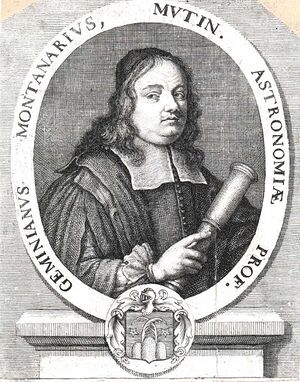Geminiano Montanari (nonfiction)
Geminiano Montanari (June 1, 1633 – October 13, 1687) was an Italian astronomer, lens-maker, and proponent of the experimental approach to science.
He is best known for his observation, made around 1667, that the second brightest star (called Algol as derived from its name in Arabic) in the constellation of Perseus varied in brightness. It is likely that others had observed this effect before, but Montanari was the first named astronomer to record it. The star's names in Arabic, Hebrew and other languages, all of which have a meaning of "ghoul" or "demon", imply that its unusual behavior had long been recognised.
Montanari was born in Modena, studied law in Florence, and graduated from the University of Salzburg. In 1662 or 1663 he moved to Bologna, where he drew an accurate map of the Moon using an ocular micrometer of his own making. He also made observations on capillarity and other problems in statics, and suggested that the viscosity of a liquid depended on the shape of its molecules. In 1669 he succeeded Giovanni Cassini as astronomy teacher at the observatory of Panzano, near Modena, where one of his duties was to compile an astrological almanac. He did so in 1665, but perpetrated a deliberate hoax by writing the almanac entirely at random, to show that predictions made by chance were as likely to be fulfilled as those made by astrology. In the period shortly after Galileo Galilei, experimentalists like Montanari were engaged in a battle against the more mystical views of scientists such as Donato Rossetti.
On 21 March 1676 Montanari reported a sighting of a comet to Edmund Halley. Montanari's observations of the great comet of 1680 are mentioned twice in the third volume of Isaac Newton's Principia.
He also wrote on economics, observing that demand for a particular commodity was fixed, and making comments on coinage and the value of money (1683).
In the News
Fiction cross-reference
Nonfiction cross-reference
External links:
- Geminiano Montanari @ Wikipedia
Attribution:
